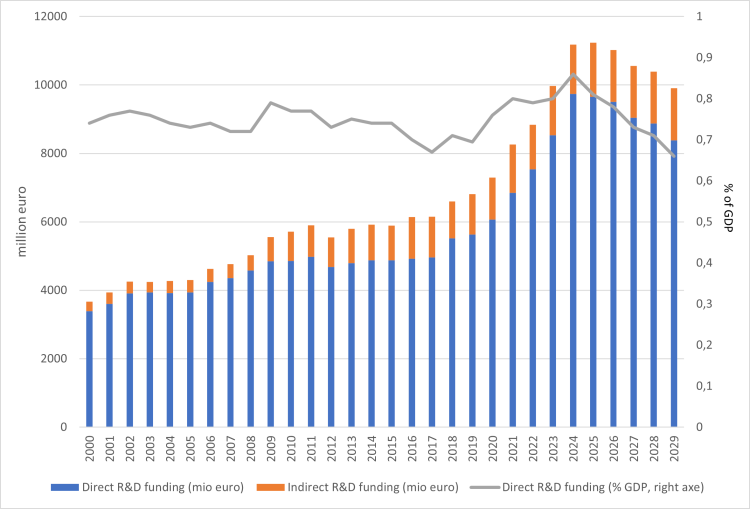Government funding of R&D
Governments are important financiers of R&D. In the Netherlands, government finances about a third of total R&D expenditure. In this factsheet we provide insight into Dutch government spending on Research & Development (R&D) and innovation. And place these publications in an international perspective. We also look at regional and European expenditure.

In short
- Absolute government R&D expenditure rises from 4.7 billion in 2012 to 9.7 billion in 2024.
- The ministries of Higher Education, Culture and Science and Economic Affairs together fund 83% of R&D expenditures in 2024.
- Indirect R&D expenditure of the Dutch government is equal to the OECD-average and slightly above the EU-27 average.
The fact sheet is divided into five sections. We look at:
- national government expenditure on R&D;
- national government expenditure on innovation;
- national government expenditure in international perspective;
- regional expenditure;
- European expenditure.
1. Developments in government expenditure on R&D
The government finances R&D directly (through basic or project financing) or indirectly (in the form of tax support).
The following graph shows from 2000 the two forms of government support for R&D - both direct financing and fiscal support. Direct investments are presented as a percentage of gross domestic product (gdp) to place them in the context of the economy.
Government expenditures and percentage GDP

Notes: The numbers are based on the various budgets of the departments. It concerns the budgets for R&D of the national government: the budgets of the provinces are not included in this. The fiscal part only concerns the WBSO / RDA, which is aimed at R&D (MIA / VAMIL are only aimed at innovation and are not included here).
In the graph above, we see government direct R&D expenditure (in euros) increasing annually up to 2011. There was a decline in 2012. Subsequently, the total amount of government support in the long-term budget shows a slightly increasing trend until 2017. From 2017 to 2024, R&D expenditures rose faster due to the extra investments from the 2017 Coalition Agreement. The increases from 2021 are mainly due to the National Growth Fund and the Ministry of Education. A decline in R&D-expenditure is expected after 2024. The decline is mainly caused by the decision of the current government coalition to cancel the fourth and fifth rounds of the National Growth Fund and cuts in the research funding for universities and university medical centers. A part of the extra investments of the previous government coalition is reversed by the current one.
The following table looks at the development of R&D expenditure per department in the period 2023-2029. An innovation-relevant component can be distinguished within R&D expenditure, which we will return to later in this fact sheet.
Government R&D budgets by ministry, in millions of euros and as percentage of GDP
| 2023 | 2024 | 2025 | 2026 | 2027 | 2028 | 2029 | |
| Realization | Preliminary | Budget | Long-Term Estimate | ||||
| Education, Culture and Science | 5839,9 | 6272 | 5973,4 | 5932,5 | 5809,7 | 5752,7 | 5731 |
| Economic Affairs/Climate Policy and Green Growth | 1311,7 | 1792,8 | 1825,1 | 1784,3 | 1622,8 | 1539,9 | 1240,2 |
| Health, Welfare and Sport | 548 | 579,7 | 510,5 | 461,3 | 380,8 | 341,7 | 291,2 |
| Agriculture, Fisheries, Food Security and Nature | 313,5 | 405 | 549,9 | 435,6 | 395,8 | 407,9 | 291,2 |
| Defence | 214,3 | 271,4 | 301,3 | 283 | 297,5 | 311,9 | 316,1 |
| Infrastructure and Water Management | 182 | 223,5 | 241,8 | 223,2 | 214,2 | 203,3 | 213,5 |
| Foreign Affairs | 49,4 | 53,2 | 48,2 | 49,6 | 49,3 | 47,5 | 47,5 |
| Justice and Security | 29,7 | 31,6 | 31,7 | 31,3 | 31,3 | 30 | 30 |
| Social Affairs and Employment | 14,4 | 12,6 | 13,6 | 17 | 18,3 | 18,1 | 18,1 |
| Interior and Kingdom Relations | 28,4 | 41,4 | 40,7 | 25,4 | 18 | 10,6 | 10,6 |
| General Affairs | 0,6 | 0,6 | 0,6 | 0,6 | 0,6 | 0,6 | 0,6 |
| National Growth Fund | 0 | 51,6 | 116,7 | 263,4 | 204,5 | 209,9 | 196,6 |
| Total | 8532 | 9735,4 | 9653,6 | 9507,1 | 9042,8 | 8874,2 | 8386,6 |
| Total in percentage of GDP | 0,8 | 0,86 | 0,81 | 0,78 | 0,73 | 0,71 | 0,66 |
The table shows that the Ministry of Education, Culture and Science and the Ministry of Economic Affairs and Climate Policy are by far the two largest financiers of R&D, together responsible for 83 percent of the expenditure in 2024. From 2021, resources from the National Growth Fund are integrated within the budgets of the ministries. The R&D-expenditures from this fund grow from 241 million euros in 2023 to 765 million euros in 2025. After that, a decline is expected.
After 2024, the R&D expenditure decreases in both absolute and relative sense. The expected R&D-expenditure declines by 14 percent between 2024 and 2029. In terms of the percentage of bbp, a decline of 0,19% is expected, from 0,86% in 2024 to 0,66% in 2029. These lopng-term estimates have not come below the 0,70% mark since the estimates based on the government budget of 2020.
2. Innovation and innovation-related expenditure
Since 2014, figures on government spending on innovation have been gathered alongside government spending on R&D.
The following table shows the different forms of government support for R&D and innovation for 2023-2029. In 2023, 75% of the total government contribution to R&D and innovation will consist of direct expenditure on R&D. 16% consists of indirect tax aid for R&D and innovation. Direct innovation expenditure is 10%.
Direct and indirect financial support for R&D and innovation, in millions of euros
| 2023 | 2024 | 2025 | 2026 | 2027 | 2028 | 2029 | |
| Realisation | Provisional | Budget | Multi-annual estimates | ||||
| R&D expenditure | 8.532,0 | 9.735,4 | 9.653,6 | 9.507,1 | 9.042,8 | 8.874,2 | 8.386,6 |
| of which innovation relevant | 2.047,2 | 2.704,9 | 2.817,9 | 2.858,1 | 2.612,2 | 2.540,3 | 2.255,6 |
| Expenditures on non-R&D innovation | 1.086,5 | 1.587,0 | 2.106,4 | 2.295,4 | 1.942,3 | 1.611,5 | 1.182,6 |
| Fiscal support for R&D and innovation | 1.770,0 | 1.667,0 | 1.805,0 | 1.737,0 | 1.762,0 | 1.762,0 | 1.762,0 |
| of which only for innovation | 329,0 | 217,0 | 219,0 | 219,0 | 244,0 | 244,0 | 244,0 |
| Total expenditure for R&D and innovation | 11.388,5 | 12.989,4 | 13.565,1 | 13.539,5 | 12.747,1 | 12.247,7 | 11.331,2 |
3. International comparison of government funding of R&D
How does R&D spending in the Netherlands compare with that in other countries? The figure below compares government spending on R&D (as a proportion of GDP) in a number of European countries. The figure shows that the Netherlands is slightly above the OESO average and the average of the EU-27 countries.
| 2023 | |
| JPN | 1,6 |
| KOR | 1,29 |
| DEU | 1,05 |
| CHE | 0,98 |
| AUT | 0,87 |
| DNK | 0,87 |
| FIN | 0,86 |
| NOR | 0,83 |
| NLD | 0,8 |
| OECD | 0,73 |
| EU-27 | 0,72 |
| SWE | 0,72 |
| US | 0,72 |
| FRA | 0,65 |
| BEL | 0,65 |
| ITA | 0,63 |
| UK | 0,61 |
| ESP | 0,6 |
| IRE | 0,21 |
For a good comparison, fiscal support should also be included in direct R&D expenditure. Most countries have such schemes; only a few do not (yet) (Germany and Switzerland). As percentage of GDP, the size of government support through tax incentives varies from 0 to 0.30%; in the Netherlands it is 0.13% (2023). This is equal to the OECD-average and slightly above the EU-27 average (0.10%)(see data publication Government support for R&D, in % of GDP). the last few years indirect R&D expenditure has declined as a percentage of GDP for the Netherlands and more countries are outperforming the Netherlands.
4. Regional
Activities related to knowledge and innovation also take place at regional level. However, a survey of funding for knowledge development and innovation at regional level was carried out for the 2013-2019 edition of TWIN. This funding comprises European resources, provincial resources and matched funding from central government. Regional development agencies, management authorities and other regional organisations are also involved. Up to and including 2023, the budgets that the provinces committed for knowledge and innovation were between €137 and €270 million. The investments were relatively high in 2020 and 2021, partly because extra resources have been made available in connection with COVID-19, but also because of new projects and initiatives. The provinces have budgeted a total of € 222 million for knowledge and innovation in 2024.
5. Europe
The European Union also contributes to the funding of R&D in the Netherlands. Since 1984 this has mainly been in the form of funding under the Framework Programmes, which has grown steadily. Horizon 2020 (2014-2020) had a total budget of €77 billion. Horizon Europe (2021-2017) started medio April 2021 and has a total budget of €93.5 billion. Dutch institutions, both public and private, acquired a relatively large amount of funding from Horizon 2020 and Horizon Europe so far, amounting to one-and-a-half times the Dutch contribution to the programme. Dutch researchers received €5.4 billion of Horizon 2020 funding, representing 7.9% of the total. In Horizon Europe 8.7% of the total budget went to Dutch researchers so far. Since the United Kingdom has left the EU and has only started participating in Horizon Europe as an associated country in 2024, the percentage is higher for most European countries, including the Netherlands.